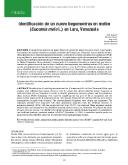| dc.description.abstract | Se recolectaron muestras de ápices foliares de plantas de melón (Cucumis melo L.) que mostraban síntomas de mosaico clorótico en campos cultivados del Estado de Lara, Venezuela. Con el objetivo de identificar geminivirus, se utilizaron iniciadores generales y la técnica de reacción en cadena de la polimerasa (PCR) para amplificar la parte superior del componente A y la región hipervariable del componente B del genoma viral. en cuatro muestras representativas, se obtuvieron fragmentos de 1400 y 400 pares de bases, respectivamente. Dichos fragmentos fueron clonados y secuenciados. Las secuencias obtenidas se compararon con otras secuencias de geminivirus en la base de datos GenBank, determinándose una similitud máxima (82 por ciento) con el virus de enrollamiento de la hoja del ayote (squash leaf curl virus, SLCV). Estos análisis de secuencia indican que se identificó un nuevo geminivirus en melón en el estado Lara, Venezuela, para el cual se propuso el nombre de melon chlorotic mosaic virus (MCMV). Se reportó la secuencia obtenida al GenBank (número de acceso AF453447, 11 de diciembre del 2001). además, se generó una sonda molecular específica para el MCMV, que se utilizará para estudios epidemiológicos futuros Foliar apex samples were collected from melon (Cucumis melo L.) plants that showed chlorotic mosaic symptoms in cultivated fields of Lara, Venezuela. In order to identify geminivirus, universal primers and the polimerase chain reaction (PCR) technology were used for amplifying the top part of the A component and the hypervariable region of the B component of the viral genome. Fragments of 1400 and 400 base pairs in four representative samples were obtained. The above mentioned fragments were cloned and sequenced. The sequences obtained were compared with other geminivirus sequences from the GenBank database. A maximum similarity (82 per cent) with the squash leaf curl virus (SLCV) was observed. These sequence anlyses indicate that a new geminivirus was identified in melon cultivars from Lara, Venezuela. we propose the name of melon chlorotic mosaic virus (MCMV) for the new geminivirus and the obtained sequence was submitted to the GenBank database (accession number AF453447, December 11, 2001). A molecular specific probe was generated to detect MCMV and it will be useful for future epidemiological studies. | es_ES |


